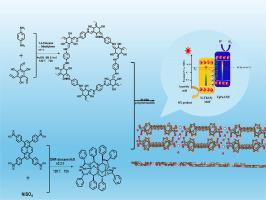2D/2D COF/MOF S-Scheme heterojunction boosts photocatalytic H2 evolution
IF 14.3
1区 材料科学
Q1 MATERIALS SCIENCE, MULTIDISCIPLINARY
引用次数: 0
Abstract
Covalent organic frameworks (COFs) hold great promise for photocatalysis; however, their activity for photocatalytic hydrogen evolution is frequently hindered by the critical limitation of rapid charge recombination. Herein, we report an S-scheme MOF/COF heterojunction synthesized through a facile in-situ growth approach. This architecture was evaluated for its photocatalytic hydrogen production performance. This innovative S-scheme heterojunction architecture synergistically improves light harvesting, enhances redox capability, and facilitates effective separation and transport of photogenerated charge carriers and exciton dissociation, thus significantly boosting photocatalytic hydrogen evolution activity. Under optimal conditions, the COF/MOF S-Scheme heterojunction exhibits a maximum photocatalytic hydrogen production rate of 276.01 mmol g−1 h−1, representing a 2.24-fold improvement over the parent COF. Comprehensive mechanistic studies, including in-situ XPS and femtosecond transient absorption spectroscopy, elucidate the S-scheme charge transfer pathway and promote charge separation dynamics, while the strategic integration of Ni metal nodes with Pt cocatalysts simultaneously optimizes charge transfer and active sites. These findings offer valuable insights for precisely designing various kinds of COF-based S-scheme heterojunctions, advancing sustainable solar-to-hydrogen energy conversion.

2D/2D COF/MOF S-Scheme异质结促进光催化析氢
共价有机框架(COFs)在光催化方面具有广阔的应用前景;然而,它们的光催化析氢活性经常受到快速电荷重组的临界限制。本文报道了一种通过原位生长方法合成的S-scheme MOF/COF异质结。对该结构的光催化制氢性能进行了评价。这种创新的S-scheme异质结结构协同提高了光收集,增强了氧化还原能力,促进了光生电荷载流子的有效分离和传输以及激子的解离,从而显著提高了光催化析氢活性。在最佳条件下,COF/MOF S-Scheme异质结的最大光催化产氢速率为276.01 mmol g−1 h−1,比母体COF提高了2.24倍。包括原位XPS和飞秒瞬态吸收光谱在内的综合机理研究阐明了S-scheme电荷转移途径,促进了电荷分离动力学,而Ni金属节点与Pt共催化剂的战略性集成同时优化了电荷转移和活性位点。这些发现为精确设计各种基于cof的S-scheme异质结,推进可持续的太阳能-氢能源转换提供了有价值的见解。
本文章由计算机程序翻译,如有差异,请以英文原文为准。
求助全文
约1分钟内获得全文
求助全文
来源期刊

Journal of Materials Science & Technology
工程技术-材料科学:综合
CiteScore
20.00
自引率
11.00%
发文量
995
审稿时长
13 days
期刊介绍:
Journal of Materials Science & Technology strives to promote global collaboration in the field of materials science and technology. It primarily publishes original research papers, invited review articles, letters, research notes, and summaries of scientific achievements. The journal covers a wide range of materials science and technology topics, including metallic materials, inorganic nonmetallic materials, and composite materials.
 求助内容:
求助内容: 应助结果提醒方式:
应助结果提醒方式:


